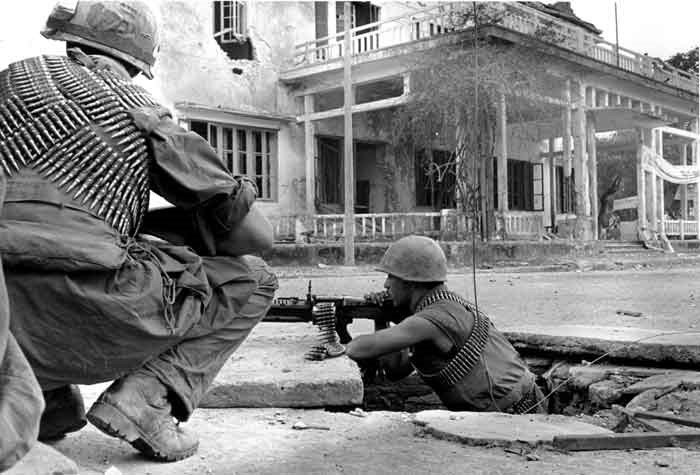Battle of Hue Begins
January 31, 1968

As part of the Tet Offensive, Communist troops assault the fortified city of Hue, the old Vietnamese imperial capital. They successfully occupy much of the city for several weeks. Though isolated, South Vietnamese and U.S. Marine and Army troops resist the attackers in bitter house-to-house fighting, resulting in high military and civilian casualties. U.S. Marine Task Force X-Ray fights its way into Hue’s MACV compound and retakes buildings south of the Perfume River.
Later, additional South Vietnamese and U.S. troops arrive as reinforcements.
The battle for Hue continues for almost a month. The Viet Cong arrest and execute as many as 3,000 civilians, which goes largely unreported at the time. The battle ravages the city, destroying or damaging as much as 80 percent of its structures. Over 100,000 people are left homeless.1
The month-long battle for Hue was one of the bloodiest engagements of the Tet Offensive and the war in general. Since Hue was the imperial capital of French Indochina, Communist forces devoted significant resources toward capturing and holding the city for its propaganda value. After the difficult fight to clear Hue of Communist forces, American and South Vietnamese troops made a grisly discovery when they secured the city: Viet Cong insurgents had executed at least three thousand civilians and former government officials during their occupation of the city. Historians differ on whether the Communists’ actions in Hue constituted premeditated war crimes, and they disagree whether large numbers of South Vietnamese civilians repudiated communism and embraced the government in Saigon as a result of this atrocity. Most historians agree, however, that the Western press corps devoted significantly more attention to U. S. combat troops’ massacre of South Vietnamese civilians at My Lai than to the Communist atrocities in Hue that same year, a disparity that may have contributed to the American public’s waning support for the war after the Tet Offensive.
Hess, Gary R. Vietnam: Explaining America’s Lost War. Malden, MA: Blackwell Publishing, 2009
Pike, Douglas. The Viet-Cong Strategy of Terror. Saigon: United States Mission, Viet-Nam, 1970.
Willbanks, James H. The Tet Offensive: A Concise History. New York: Columbia University Press, 2007.